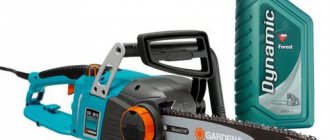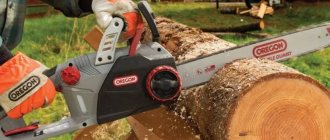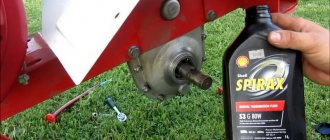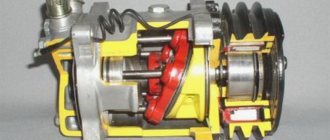Possible malfunctions of the chainsaw
As a rule, the breakdown of a chainsaw is associated with the failure of the engine or its parts due to violation of the rules of operation and storage of the tool.
Problems of a different nature are also possible, such as, for example, a breakdown of the chain lubrication system or malfunction of the chain brake. Thus, the main malfunctions of chainsaws that our service center technicians encounter in practice are:
- Problems with the ignition system
- Fuel system malfunctions
- Carburetor malfunction
- Exhaust system malfunctions
- Wear or damage to the elements of the cylinder-piston group
- Breakdown of the chain lubrication system
- Chain brake malfunctions
Reasons for decreased system performance and efficiency
The required amount of oil is not supplied to chain for several reasons. The most common failures include:
- clogging of the filter located in the oil tank;
- mechanical failure of one of the pump worm drive elements;
- In winter, the performance of the blower is reduced due to filling the system with too thick oil.
In the latter case, the drive and all pump parts operate under increased loads, causing serious mechanical damage.
How to install a chain
A long service life of the device is possible not only if the components for it are carefully selected, but the installation of the chain on the chainsaw must also be correct. In addition, sooner or later the chain may need to be replaced. In this case, it is necessary to think about safety, in particular, carry out work using special protective gloves. To “dress” the saw, you need to perform actions in the following sequence:
- Prepare the surface for work. You can place the chain correctly on a table or other convenient and flat surface. Additionally, the surface can be covered with a rug.
- The wing nut on the housing must be unscrewed, and then the sprocket cover must be removed.
- The latter must be turned to the right all the way. After this, gradually put the chain on top of the bar, while it is better to start work from its top. At each stage, it is recommended to ensure that the chain is directed correctly.
- Turn the chain so that the bar is on top of it. At this stage, the cutter located on the top of the tire should be facing forward, not to the side. This indicates that the direction of movement is correct and the location is accurate.
- Place the tire on the sprocket.
- After this, put the chain sprocket cover on the engine block, turn the wing nut until it stops, but do not completely tighten the sprocket cover.
- Unscrew the clamping screw by turning it towards the top of the bar, while the chain links should fall into the corresponding recesses.
- Tighten the wing nut until secure.
- Check the part for sagging and tightness, and if necessary, tighten it further or loosen it.
Why does the chain fly off and break?
If the chain falls off the chainsaw or it breaks, this means that there is some kind of problem with the device; under normal conditions it should not do this. There are three reasons why a chain falls off:
- Tire problems. They lead to loosening of the tension, which can lead to the chain breaking. Most often, this problem occurs in the groove between the outer plate on the chain set housing and the inner plate on the motor housing. The casing with the tire is secured with a bolt, which can become loose during operation of the chainsaw, as a result of which the tire begins to move or vibrate. To solve this problem, you need to find and lower the chain brake, for which you need to turn the tension screw, which is located next to the tire, until it is fully tensioned.
- The chain has stretched. Sagging may indicate a malfunction of the chainsaw mechanism. During operation, the metal is deformed, which means it can become 0.5-1 cm longer. In this case, it is recommended to replace or shorten the chain.
- The drive sprocket is poorly secured. To secure it, you need to remove the engine protective cover and spark plugs, and then pull out the air filter. The spark plug itself also needs to be unscrewed, after which a special stopper is installed in its place to secure the piston. Turn the fastening disk clockwise until the piston stops in the uppermost position. A thick rope folded several times can act as a stopper. After fixing the piston, clamp the drive sprocket. Reassemble the chainsaw, installing all parts in the reverse order.
Most problems can be solved by repair. Only in exceptional cases will it be necessary to change it.
Chainsaw Chain Oil How to Replace
Oil for chainsaw chains. What oil should I use to lubricate a chainsaw chain?
Chainsaws are a popular tool for those who have to do countless household chores without the help of others. They can be used for various purposes - preparing firewood, cutting dry branches... But in order for the device to last as long as possible, it is necessary to properly care for it, choosing different compositions well. A special role is played by oil for chainsaw chains, which is selected depending on the operating mechanisms of the tool and its features.
What to consider?
Careful attention should be paid to lubricating the saw chain. Chain oil for chainsaw / household solution
First, you should choose a special oil that will not harm the oil pump. In addition, this will ensure proper operation of the self-lubrication system. The chain also requires proper storage, in other words, immersion in oil, and if it wears out, you shouldn’t try to revive an old chain - it’s easier to change it. Which oil to choose for chainsaw chains so that it is non-hazardous and meets all requirements?
Types and composition
You should choose a specific oil depending on where and how the chainsaw is used. Mineral compositions are suitable for summer and warm seasons. What oil should I use for my chainsaw? Oil must be used to lubricate the chain and to mix with gasoline. In other cases, it is better to use synthetic or semi-synthetic oils. If you need to lubricate the chain, you should not use waste oils, which will lead to clogging of the fuel system, and then to severe damage to the tool.
Chainsaw chain oil must be carefully cleaned so that lubrication is carried out well and accurately. If you use poor compounds, there will be no contact between the elements of the saw and the bar, sparks will appear, and then the moving parts of the saw will wear out.
How to choose?
Any chainsaw has a two-stroke carburetor engine and two tanks: one is filled with gasoline, the other with oil. When choosing a lubricant composition, zoning plays an important role - it should be small. Another important indicator is resistance to low temperatures: the oil should not solidify at extreme temperatures, which will ensure the quality of operation of the entire tool.
Oil does not flow to the chain, what are the reasons?
It is not always possible during operation to immediately see that oil to chain . Signs of lack of lubrication:
- the level in the tank does not decrease;
- cutting is difficult, accompanied by the smell of burnt wood;
- Oil droplets do not fly off the tip of the chainsaw bar.
Having discovered a malfunction in the oil system, you need to determine its cause. There are a few of them - clogging, a broken hose or a malfunction of the oil pump.
Most often, the oil supply channel becomes clogged with dirt and sawdust. Blowing with air or cleaning with a thin wire is enough to eliminate the problem. The oil tank has its own internal filter. When using normal oil, it is unlikely that it will become clogged, but when it is filled with oil, it is quite possible. Will have to clean it up.
The oil hose may be damaged or completely broken. You can temporarily seal the damaged area, but it will be safer to replace it with a new one.
And the most serious problem is a breakdown of the oil pump. The reasons may be different - the teeth of the worm gear have worn out, the plunger has jammed, etc. Removing the pump and replacing the damaged part yourself will not be easy. It is safer and easier to contact a service center.
The service life of any mechanical device is affected by the quality of consumables and the timeliness of their replacement. An example is changing the oil in a chainsaw.
How should a chain oil lubrication system work?
To ensure reliable operation of the chainsaw, a special chain oil lubrication system is installed. An example is the following information:
Fuel tanks are selected by volume, taking into account that when the fuel is completely used up, some oil should remain
In addition, it is important to correctly set the carburetor so that fuel is not quickly produced. With a slow decrease in oil at the time of use of the saw, the lubrication efficiency decreases several times, and the conductivity of the channels also decreases. Over time, a malfunction may appear that will be quite difficult to fix. It is recommended to check the condition of the oil pump from time to time
If necessary, you can adjust the performance using a special screw. You can check the correct operation of the pump yourself. To do this, the tire is brought to an illuminated surface. If oil splashes appear on it, then the design is working correctly. Lubricant consumption is adjusted depending on the specific situation.
Saw chain lubrication system
A sign that an insufficient amount of lubricant is getting into the cutting zone is strong heating and the appearance of smoke and an unpleasant odor when cutting wood. When heated strongly, the metal expands, causing the chain to become pinched in the groove. The effectiveness of the degree of lubrication decreases when the tire gets into the ground. That is why, if the saw is not used carefully, it will quickly wear out. When chain oil comes into contact with the ground, it collects various substances, due to which the heating of the metal accelerates.
Universality problems
Universal oil for lubricating chainsaw chains has relatively unattractive performance properties. It is worth considering that even lubricant manufacturers do not indicate their 100% versatility.
An incorrect choice leads to the fact that the wear of the structure increases by approximately 10% and the working life of the saw set is reduced.
The information above indicates that there are no universal options for oils. That is why when choosing, you need to pay attention to operational properties, in particular, temperature conditions.
Train tips
It’s not enough to know how to solve problems with a broken or broken chain, because there is always the opportunity to prevent this. Proper care of your saw will help extend the life of the device and its parts. Therefore, it is recommended to follow the advice of experts:
- Clean the air filter regularly and lubricate it with oil. The filter needs to be changed periodically.
- Each time before starting work, you need to check that all nuts and bolts are securely tightened. Then there will be no failures in the device during operation.
- Both the bearings and the sprocket need to be lubricated.
- Clean burnt candles regularly.
- Lubricate, sharpen and tension the chain in a timely manner.
A high-quality chainsaw, provided proper care and timely repairs, can last longer than the warranty period.
When the saw chain of a chainsaw moves in the groove of the bar due to friction, a large amount of heat is released. If oil does not flow to the chainsaw chain, it is necessary to stop work and take all measures to eliminate the malfunction of the lubrication system. The combination of heavy loads and overheating of the headset is accompanied by its accelerated wear and early failure.
- Without exception, all chainsaws and their electric analogues are equipped with systems of the same operating principle, through which the lubrication of the bar, saw chain and its drive parts is carried out.
- The standard composition of this device includes a reservoir from which chain oil is supplied to the inlet of a pump with a fixed or adjustable capacity.
- Next, the working fluid in a dosed amount enters the groove of the bar, in which it is evenly distributed by the shanks of the saw chain over the entire headset and the working surface of the drive sprocket crown.
Read also: Tungsten, what kind of material is it?
Performance tires with a length of 400 mm or more are equipped with a driven sprocket. Periodic lubrication of the bearing is carried out individually, after 6-8 hours of operation.
Starting the engine: checking the spark plugs
If the chainsaw does not start, the first thing to do is check for the presence of a fuel mixture in the tank. By the way, it must be prepared in the proportions specified by the engine manufacturer, otherwise the tool simply will not start.
After making sure that the fuel mixture is correct and available, you should check the ignition system. To do this, you need to inspect the spark plug.
Her condition can say a lot:
dry candle
indicates that the fuel mixture does not enter the carburetor, which means the problem is not in the ignition;
fuel-spattered candle
is the result of an excess of the fuel mixture, which lies either in a violation of the engine starting algorithm or in incorrect carburetor adjustment;
carbonated candle
This is a signal about the presence of low-quality oil in the engine lubrication system, incorrect carburetor settings, or an incorrectly prepared fuel mixture.
If the spark plug is splashed with fuel, it must be thoroughly wiped after removal. The fuel supply system should also be cleaned. To do this, it is closed, after which the starter is turned on. A candle covered with soot must be carefully cleaned using an awl and sandpaper.
When checking spark plugs, you should pay attention to the distance between the electrodes (the normal gap is 0.5-0.65 mm), as well as the condition of the gasket and the presence of a spark. A damaged or worn gasket will need to be replaced, and the spark can be checked by putting on the ignition cable, connecting the cylinder and spark plug nut and starting the starter
Video about igniting a chainsaw
Video about the ignition device of a chainsaw. What components does it consist of, why is this or that necessary?
The following video explains how to replace the ignition on a modern chainsaw. This video tutorial is suitable for almost all chainsaws. Of course there may be nuances, but the general meaning is the same.
Prevention
Improper care and use of the tool will shorten its service life. To extend its service life until the next repair, it is necessary to follow some preventive recommendations.
- Before each start, check the serviceability and tension of the chain, as well as the sharpness of the teeth.
- During the sawing process, give the tool a periodic rest, especially if we are talking about household or semi-professional class chainsaws.
- After completing the work, clean the chain, tire, air filter, housing and other cracks and grooves where sawdust could get in.
- Rotate the tire periodically to ensure even tire wear.
- Use only high-quality types of oils and fuels.
- You cannot store the fuel mixture for a long time, so drain the remainder from the tool and dispose of it.
Work should only be carried out when you are sure that everything is in order. Performing such simple preventive procedures can significantly extend the service life of the tool.
Article rating:
Loading…
This is interesting: The structure of a chainsaw and important rules for handling gas-powered tools: we outline them in detail
The structure of the chainsaw lubrication mechanism and how it works
The bar acts as a guide for the chain, but both of these devices are made of metal. Rotating the chain at high speed causes the metal to heat up due to friction. If you do not cool the moving chain while operating the chainsaw, this will lead not only to its almost instant wear, but also to failure of the tire. To eliminate negative consequences, chain lubrication mechanisms are used in all types and models of saws (not only gasoline, but also electric). They not only cool the metal when it heats up, but also reduce the friction of the chain on the surface of the tire.
The chainsaw chain lubrication mechanism is presented in the form of an oil pump operating in automatic mode. Oil supply occurs only when the engine is running, and the higher the speed, the more often lubrication occurs. Chainsaws use plunger pumps, also called piston pumps.
Let’s look at the principle of operation of the chainsaw oil pump in detail, having first clarified its design:
- The oil pump housing, which is made not only of aluminum, but also of plastic. Plastic versions of oil pumps are used mainly on household chainsaws
- A plunger is a cylindrical part through which oil is pumped. The plunger consists of a worm gear, through which it is driven
- Supply and exhaust channels that connect to oil lines
Now let's look at the principle of operation of the plunger oil pump of a chainsaw. The plunger shaft of the pump is driven by the rotation of the drive chain sprocket. To ensure torque transmission, the chainsaw oil pump has a gear drive. Torque is transmitted to the driven gear of the pump only when the chain moves, so at idle. The pump does not pump oil into the engine.
- From the end side, the plunger shaft rests against the rod. This rod on some oil pump models is adjustable. The plunger shaft has a wave-shaped wall design, as shown in the photo below
- The reverse side of the plunger, which is called the working side, has a design in the form of a segmented protrusion or cutout, as shown in the photo below
- The plunger part rotates, thereby opening the supply channel for the intake of a portion of oil from the oil tank. Next, the outlet channel opens, from where a portion of oil comes out, entering the bar to lubricate the chain. The operating diagram of the plunger mechanism is presented below
The operating principle of a chainsaw oil pump is quite simple, which has a positive effect on its cost. The oil pump can be repaired, but if the wave-shaped end protrusion wears out, it is recommended to replace the part or mechanism.
This is interesting!
Oil pumps may have an adjusting screw in their design, through which the performance of the mechanism can be adjusted.
If the chainsaw's oil pump fails, it is prohibited to operate the tool. After starting the chainsaw, you can check the serviceability of the oil pump in the following way - place a clean sheet of paper in front of the tire and turn on the gas. Oily spots should appear on the sheet.
Performance properties
When producing branded and standard oils, standards related to viscosity or density, as well as the concentration of foreign impurities, are taken into account. Among the features we note the following points:
- Organic and mineral compositions practically do not differ in their performance qualities. This is due to the fact that the lubricant flies off the surface of the tire quite quickly. There is no point in overpaying significantly for the purchase of expensive lubricants, since the difference is insignificant.
- The protective properties of mineral compositions are significantly higher than those of natural ones. That is why it is recommended to use such oils for one-time work.
- If there are only a few days between jobs, then it is recommended to use organic compounds. They are much cheaper than mineral ones and are characterized by high efficiency in use.
If you are using lubricant for the first time, you should hold the saw at medium speed for several minutes and check whether it is suitable for your specific model. Such oils are also characterized by the temperature at which they can maintain their performance characteristics.
Chainsaw training? what oil to use to lubricate the chain
Sources:
https://stankiexpert.ru/ehlektroinstrument/maslo-dlya-smazki-cepi-benzopily.html
Main characteristics
The Shtil chainsaw chain lubrication system consists of:
- guide bar;
- saw chain;
- oil pump.
The oil supply by the pump has a special adjustment. The chainsaw chain is lubricated constantly during operation of the device. Therefore, chainsaw chains have a long service life.
During operation, the chain requires a constant supply of lubricant. Its continuous supply must be ensured. This is required by the design of the device. While the chainsaw is running, the oil leaves the bar groove and is instantly absorbed by the sawdust.
For this reason, the chain is lubricated automatically. Some chainsaw chains are equipped with a system that regulates the exact amount of lubricant supplied. The cheapest devices are equipped with a hand pump, which is powered by a drive located on the handle.
Scheme for checking the operation of the chain lubrication system.
A special oil has been specially developed for good chain lubrication. After use, it quickly decomposes, so there is no disruption to the ecological system. You can also use the following brand oils:
- M6;
- M8.
The gear lubricant is absolutely not suitable for the job. In winter, it hardens, as a result the oil system becomes clogged, and you have to clean it completely.
In winter, chain lubrication requires special attention. in severe frost it thickens and resembles Vaseline. Therefore, to operate in winter, it is necessary to lubricate chainsaws with special winter oil, which has a thinner consistency.
It is not always possible to purchase such a lubricant. To solve the problem, diesel fuel is mixed with oil, the viscosity is reduced. However, if the previously filled oil remains in the crankcase, then adding diluted oil will not have a positive effect; the system channels will remain clogged. There is only one way out - heating the chainsaw in a warm room.
If the chain oil does not solidify too much, you can try to melt it by running the saw at low idle speed.
Checking the system for oil output and performance
A dirty oil filter results in a significant reduction in pump performance. It is easy to check this parameter. To do this, you need to hold the headset of the saw running at working speed over a clean sheet of paper.
Based on the density and size of the oil strip, you can confidently judge the condition of the system and the complexity of the upcoming repair.
To the question why the repaired lubrication system works, but the chain in the required quantity, there is no definite answer. The reason for the failure may be errors made during assembly, failure of standard adjustments, or a discrepancy between the density and viscosity of the selected composition and the declared characteristics.
Oil starvation of the headset is possible when installing a longer productive bar on a household saw with a non-regulated pump, which is included with professional-class chainsaw equipment.
What is needed to fix the problem?
Repairing a chainsaw does not require a large arsenal of household tools. First of all, this:
- screwdrivers. Cross and flat to remove the casing, chain or other components that are fastened with flat bolts and will definitely be needed to properly repair the chainsaw;
- a set of spanners and wrenches of different sizes. They will be needed when disassembling the engine and other moving parts. Repairing such parts sometimes involves dry cleaning, so they will be needed to scrape off excess dirt;
- key for removing spark plug;
- a diagram of the chainsaw itself in order to know how certain components work and how to properly maintain them.
Signs of a chainsaw engine malfunction
If you experience at least one of the symptoms listed below:
- chainsaw won't start
- chainsaw starts and stalls
- the engine does not gain power
- The engine stalls when running or runs rough
then we can say that there is a malfunction in the chainsaw engine. Below we will take a closer look at possible breakdowns and their causes.
Specifics of repairing Chinese chainsaws
A significant share of the imported chainsaw range is made up of Chinese-made chainsaw equipment. Many models have been copied with greater or less success from the best European designs.
The main advantage of Chinese products in the budget segment is the high level of interchangeability of spare parts, components and systems. To repair Chinese chainsaws, in some cases, you can use components from models from other manufacturers that are identical in power and purpose.
Main brands of motor oils for chainsaws
The leaders in the production of high-quality lubricants for chainsaws and brush cutters are the companies Shtil and Husqvarna. Their range includes both conventional mineral lubricants for two-stroke engines and synthetic oils for severe operating conditions. Let's take a closer look at the range.
STIHL HP
STIHL HP mineral lubricant was specially developed by STIHL engineers for use in their tools. That is why owners of Shtil chainsaws and lawn mowers are recommended to use this type of oil.
Its color is red, shelf life in a closed container is no more than four years. It is packaged in several types of containers, so you can choose the most convenient packaging for yourself. Not so long ago, convenient containers of 20 grams appeared, which are diluted with one liter of gasoline. For those who rarely use a chainsaw, this is the best option. Can be diluted and used immediately.
STIHL HP fully complies with high European standards.
HP Ultra
Another oil from Stihl. It has a synthetic base, due to which it has improved combustion characteristics, cleanliness and engine protection.
Recommended by the manufacturer for long-term use in harsh conditions. Ideal for working at low temperatures. HP Ultra does not harm the environment, since oil spilled on the ground decomposes by 80% in just 21 days.
Packaged in two types of containers, 100 ml and liter bottles. The proportion of the finished fuel mixture is 1:50, which means a 100 mm bottle is enough to prepare 5 liters of the mixture. Green color. Shelf life 4 years.
The cost of this oil is significantly higher than the cost of STIHL HP, so it is not profitable to use it constantly.
It is worth noting that Stihl oils, before going on sale, go through the company’s laboratory, where they are tested to ensure they meet all requirements.
When developing oils, much attention is paid to fuel combustion, cold start characteristics, biodegradability, and viscosity change at different temperatures (information from the company’s official website)
Husqvarna HP 2-stroke
Husqvarna HP oil, like its STIHL HP counterpart, is also designed specifically for 2-stroke engines.
According to the manufacturer, this type of oil has additives that compensate for the low quality of fuel, which is important for our country. The declared octane number of gasoline at gas stations rarely corresponds to the real one.
Husqvarna HP – semi-synthetic, green. Packaged in liter or ten liter containers. The proportion of the mixture is 1: 50, i.e. 20 grams per liter. During the period of running in the saw engine or when working in cold weather, it is possible to increase the proportion to 1:40, which will give the engine greater protection and increase its service life.
Today, there are a large number of lubricants for two-stroke engines on the market from different manufacturers. For this reason, answering the question of which chainsaw oil is best is quite difficult. Our opinion is that you should trust reliable companies, which are Shtil, Husqvarna, Oregon, Champion. It is their oils that will maximize the protection of your tool’s engine and extend its service life.
Unscrupulous manufacturers often disguise their products under well-known brands (Husqvarna, Shtil, etc.). Such oils are of low quality and can harm the engine. In order not to be deceived, it is necessary to purchase lubricants from official representatives who have the necessary certificates for the products. You can learn how to distinguish a fake from an original from the video:
Adjusting oil density to external temperature factors
The performance characteristics of the lubricant decrease when it is used when the ambient temperature drops to 20 degrees Celsius and below. Also, at low temperatures, the pump responsible for supplying oil does not work properly. The solution to this problem is often mixing the thickened composition with kerosene. Such an additive provides the required density of the substance, but it is still recommended to reduce the load exerted. If the ambient temperature is too low, you need to monitor the effectiveness of lubrication of the main elements. This recommendation can also be attributed to the fact that the liquid in the wood begins to freeze, increasing the hardness and reducing the degree of workability. Too high a load causes rapid wear. An increase in viscosity makes engine operation more difficult. This is why many manufacturers indicate the conditions under which a chainsaw can be used.
READ Changing the Oil in a Husqvarna Lawn Mower
How to increase the life of a chainsaw
You need to have a couple of tires and at least four chains in reserve. To ensure a uniform wear process, the chain should be turned 180° after three hours of operation, and after the same period of time the chain should be replaced with another one.
Timely cleaning of the tool ensures that various holes are not clogged, which can lead to difficulty or even interruption of the supply of the fuel mixture, which will affect the operating condition of the chainsaw.
If you are not confident in your abilities and are afraid of ruining the unit, then it is better to turn to professionals. Due to their experience, they will always be able to correctly diagnose the problem and efficiently correct problems in your chainsaw.
Tire care
Every few hours of work, it is necessary to rearrange the tire 180° so that both sides are used approximately equally.
Also, every time you fill the tank, you need to lubricate the tire sprocket so that it serves for a long time and normally, for which almost all stores sell special syringes for lubricating the sprocket. The only manufacturer that has solved this issue is Stihl with its Ematic
Very often you can hear advice that if a “dented groove” forms on the guide runners, straighten it with a file, however, if the tire does not properly groove. Moreover, if you do not maintain an ideal right angle between the file and the bar, then the “corrected” bar will last even less, since during operation the chain will wobble in the runners and break them even more strongly.
General structure of the tool
Chainsaws, or their second name chainsaws, are actively used not only for collecting firewood, but also when performing construction work, as well as for pruning the garden. Today, this tool is produced by different manufacturers - from well-known ones, such as Stihl, Husqvarna, Makita, Partner, Champion, and lesser known ones - Foresta, Start, Limex and others. Despite the differences in name, all these instruments have a similar design. The only difference lies in the quality of the parts from which the individual mechanisms are assembled.
To understand how a chainsaw works inside, you first need to know the main components of the tool. Below is a diagram of a chainsaw, by which you can find out what device this tool has.
Let’s briefly find out why all the components of a power tool are needed:
- Rear handle - plays the role of a support for holding the tool by the sawyer. On this handle there is a throttle trigger, through which the throttle valve opens.
- A fuel tank is a container into which a prepared mixture of gasoline and oil is poured. Chainsaws equipped with a two-stroke engine operate on this mixture.
- Ignition - the mechanism responsible for supplying a spark to the spark plug
- Starter handle - used to manually start the internal combustion engine. The starter is connected to the crankshaft, which must be turned to start the engine.
- The oil tank is a container into which chain oil is poured. This oil is consumed during the operation of the tool to lubricate the chain, sprocket and tire.
- Front handle - the main handle by which the tool is held when performing sawing operations
- A chain brake is a lock that allows you to instantly stop the chain if it gets stuck in the wood or if there is a danger of human contact with a rotating part of the tool.
- The guide bar is the part along which the chainsaw chain moves
- The chain is the main element that ensures sawing of wood
These are the main components of the tool in question, the purpose of which must be understood before starting work for the first time. If a chainsaw fails, then its breakdowns are mainly associated with internal mechanisms. Let’s take a closer look at how the chainsaw is structured inside and what principle of operation it has.
https://youtube.com/watch?v=mRNgs6kuVn8%3F
Chainsaw Maintenance Basics - Do It Right! - The naked truth!
The purpose of this post is to provide practical advice to anyone who owns chainsaws. We will talk about the sawing machine. Preparing the sawing machine for work, there are simple rules that will help you save from unnecessary costs. This post will also be useful for those who have no experience working with chain saws at all. The sawing apparatus consists of a chain, a bar and a drive sprocket.
You have purchased a new chain. Do not rush to place it on the bar - you need to place the chain in oil for 12 hours so that all connecting elements of the chain are saturated with it. The question may arise - why? After all, chains often come already lubricated from the manufacturer, isn’t that enough? This is only sufficient for transportation and storage. For full-time work - no! Impregnation of the chain should take at least 12 hours. Only after this procedure can you safely install the chain on the headset. An important point is chain tension. There are several requirements:
1. The chain should fit tightly to the headset. There should be no sagging at the bottom.
2. The chain should move by hand along the bar.
Another point that, as a rule, users do not observe, but it is often described in the instructions for saws. In order to tension the chain, you need to lift the tire by the “nose”, tension the chain and fix the tire.
The design of a chainsaw carburetor and the features of its functioning
If the ignition system is responsible for igniting the combustible mixture, then the carburetor is needed in order to prepare this mixture burned in the cylinder
In terms of importance, the chainsaw carburetor ranks second after the internal combustion engine. The complexity of the mechanism in question is that it consists of many small elements, so very often, instead of diagnosing, cleaning and replacing parts, many people prefer to purchase a new carburetor
Repairing and cleaning the carburetor is discussed in detail in this material (link).
Chainsaws use membrane-type carburetors. They are called membrane ones, since they not only mix fuel with air and supply it to the combustion chamber, but also independently pump the gasoline-oil mixture from the gas tank. The membrane, which is a pump, is responsible for performing this process.
The principle of operation of the carburetor and its design are described in detail in this material. The carburetor design has adjusting screws, which allows you to independently adjust the mixture composition. These are three screws that can be used to adjust the mixture at idle, as well as at low and high speeds.
Carburetors of old chainsaws produced by companies such as Druzhba, Ural and others differ in design and operating principle from modern ones. Their main difference is that they do not have a membrane mechanism, and the fuel in them is supplied by gravity from a gas tank, located mainly in the upper part of the gas tool. The use of such carburetors ensured that the chainsaw was only used in a straight position and should not be tilted. For horizontal and vertical sawing with Druzhba and Ural chainsaws, it is necessary to change the position of the tire.
This is interesting!
Special companies are engaged in the production of membrane carburetors for chainsaws. The most famous manufacturers of carburetors for chainsaws, lawn mowers and other gasoline-powered tools are Zama, Walbro. Externally, these mechanisms may differ, but their operating principle is the same.
Feature of independent troubleshooting
A complete independent repair of chainsaw chain lubrication, all things being equal, requires knowledge of the interaction of all elements of the system, the availability of tools and plumbing skills.
Restoring the operating parameters of many chainsaws involves partial or complete dismantling of the component equipment. To perform complex repair work, it is better to use the capabilities and technical potential of service workshops.
Parts with broken threads and damaged spline joints, as well as non-separable structures that come with the lubrication system of the popular STIHL 180 chainsaws and other similar models must be replaced.
READ New Chainsaw Doesn't Start Reasons
If, when the tank is filled, oil does not flow into the headset structure, the reason should be sought in the pump itself. Dismantling and disassembling the mechanism will help identify faulty parts and eliminate the problem by replacing them.
Chain tension mechanism
One of the simplest mechanisms of a chainsaw is the chain tensioner. It consists of a pin connected to a screw. The screw is driven by a special tool - a screwdriver or hex key. Rotation of the screw helps move the pin in a special groove in the tool. Along with the moving pin, the bar moves, causing tension on the chain.
The adjusting screw on chainsaws from different manufacturers can be located in different places - on the side, bottom or at the end of the tool. The quality of chain tension must be checked regularly, since a weakened chain can come off the bar groove, which will lead to tragic consequences for the sawyer. You should also not allow the chain to be over-tightened, as it will work under load and will break at one point, which can also result in serious injury. More information about chainsaw chains and tires can be found here.
Having examined the detailed design of the chainsaw, it will not be difficult to repair it yourself. You need to understand that a chainsaw is a tool that is used not only for sawing wood. The use of different attachments allows you to significantly expand the functionality of the tool. At the same time, do not forget that even the most expensive and high-quality models of tools also break down, so they need regular diagnostics, maintenance and repair.
Sprocket Lubricant
At the end of the chainsaw bar there is a driven sprocket, which ensures rotation of the chain. be lubricated periodically . For this purpose, thick materials are used. You can use STIHL universal lubricant. Domestic lithol-based lubricants are also suitable. There is a special hole on the tire for lubricating the sprocket. You need to pump lubricant into it using a grease nipple or syringe.
Please note that if you frequently work with the toe of the tire, for example, when making grooves, the load on the sprocket increases and be lubricated more often.
Sources:
https://benzopilok.ru/remont/sistema-smazki-cepi-benzopily.html https://xn80ahdapmtfjjlo4bl.xnp1ai/raznoe/chem-smazyvat-cep-benzopily-kogda-zalivat-i-kak-vybrat-pravilnuyu-marku -smazochnogo-materiala-403-dostup-zapreshhyon.html https://zemlyconsalt.ru/pily/chem-smazyvat-tsep-benzopily.html
What oils can be used
Leading manufacturers of chainsaws recommend using their own lubricants in their equipment. However, these oils often cost several times more than simpler ones from third-party manufacturers.
Please note: If you are in doubt about the choice of lubricant, then in this case, the best solution would be to purchase lubricants from the equipment manufacturer.
But what to do if for some reason it is impossible to buy expensive original oil? Here, chainsaw owners resort to different options. Let's take a general look at each of the possible lubricants for saw chains.
Original oils
Often this is the best choice in terms of performance, but not price. In addition to optimal lubricating properties, today manufacturers strive to make these lubricants biodegradable (based on rapeseed bases), which has almost no harm to the environment and human health.
Stihl chainsaw chain oil is a biodegradable product. The only significant negative is the price.
Narrow profile
Special oils for chainsaw chains from third-party manufacturers. Also a good choice. They cost significantly less than branded lubricants, but are often almost as good in performance.
Cheap industrial oil
The most common option here is the domestic product, labeled I-20 or I-20A. One of the cheapest options. This industrial oil can be poured into a chainsaw to lubricate the chain without fear of negative consequences.
The lubricant has good properties regarding the operating conditions of the saw set and can reliably protect the chain and other elements of the set from wear.
In terms of performance, it is a little inferior to the original. But the price can be several times lower than for specialized products. Therefore, this option is used by many owners of chainsaws of all brands and models.
In hot conditions, it is recommended to monitor the lubricant level during sawing after half the gas tank has been used up.
Due to its very low viscosity, industrial oil is consumed quite quickly. There are known cases where industrial lubricants were used up faster than the fuel tank ran out.
New engine or transmission lubricants
Not a very reasonable choice in economic terms. Suitable for cases where the saw is rarely used, and there is no point in buying a canister of special lubricant separately.
These oils contain a huge amount of unnecessary and useless additives for saw operation, which will only pollute the processed lumber and the environment.
Which oil is better to use for a chain - video
Here you also need to take into account viscosity indicators. The rate of oil supply to the chainsaw chain can be greatly reduced as the temperature increases the viscosity.
Greases may lose their fluidity in winter conditions and may not effectively protect the chain and tire running surfaces from wear.
In the case of motor oils, when working in winter, it is recommended to use low-viscosity options. In general, internal combustion engine lubricants can be used in saws.
Used oils
Using used oils to lubricate a chainsaw chain is the worst idea possible.
Firstly, the specific nature of the operation of a chainsaw implies the creation of an oil mist in the work area, which spreads to the surrounding nature and is partially inhaled by humans.
And the waste is a recognized carcinogen and is generally extremely toxic. Therefore, in many countries, entire industries have been created to recycle used motor and transmission oils, and unauthorized discharge into the environment is punishable by serious fines.
Secondly, the lubricating qualities of the waste are extremely low. They are tight enough for medium load conditions. If you cut a thick log or hardwood, the chain and the rest of the saw set will suffer, even to the point of irreversible destruction.
Answering the question of how to replace chain oil for a chainsaw if it is too expensive to buy the original, you can answer this way: almost any oil with a suitable viscosity. But not with detention. It is better to fill the chainsaw with products specially designed for this purpose to lubricate the chain.
How and when to pour lubricant into the reservoir? Here the answer is simple: pour gas every time you fill up to the mark on the neck.
Choosing engine oil
Saw chain oil is not always used as an all-purpose option. Often, the option for the engine from which the tire receives rotation is also filled. When choosing it, the following points are taken into account:
- You should give preference exclusively to the options recommended by the saw manufacturer.
- Mineral lubricants are more popular, as they are more effective in use.
- Products from well-known manufacturers are characterized by higher performance characteristics.
- The recommended temperature regime must also be taken into account. Some versions cannot be operated at too low a temperature, as this leads to an increase in viscosity. Too high a viscosity causes structural damage when operating at high speeds.
Various brands of chainsaw oils
If you do not add lubricant to the engine in a timely manner, it can quickly wear out or even fail.
Specifications
The tool, weighing 6.1 kg, is characterized by compact overall dimensions, simplified access to adjustment points and filler necks. The saw is equipped with a carburetor two-stroke internal combustion engine, running on a mixture of high-octane gasoline and motor oil in a ratio of 50:1. The power unit with a volume of 70.7 cm3 develops a power of 3.9 kW in operating mode.
The advantages of the engine:
- throttle response and speed stability in all operating and idle modes;
- flexible traction characteristics;
- economical fuel consumption within 1.9 l/h;
- increased torque reserve;
- easy start system;
- the ability to operate for a long time in operating mode without losing labor time for cooling.
Autonomous operation of the saw is ensured by a fuel supply in the internal tank with a volume of 771 ml.
| Manufacturer | Husqvarna |
| Production (assembly) | Sweden |
| Homeland of the brand | Sweden |
| Saw class | Professional |
| Power, hp (kW) | 5,27 (3,9) |
| Engine volume, cm3 | 70,7 |
| Chain pitch, inches | 3/8 |
| Chain thickness, mm | 1,5 |
| Number of links, pcs | 68 |
| Fuel tank volume, l | 0,77 |
| Oil tank volume, l | 0,4 |
| Tire length, cm (inches) | 45 (18) |
| Warranty, years | 1 |
| Weight, kg | 6,1 |
| Instructions | Download |











